LOOK produced environments, miniature integration, matte paintings,
particle FX, stop-motion animation and 3D projections to bring real magic
and fantasy to ‘The Grand Budapest Hotel ‘.
LOOK Effects Takes a Trip to The Grand Budapest Hotel |
| LOOK produced some 340 shots for ‘The Grand Budapest Hotel’, including environments, miniature integration, matte paintings, extensive compositing, particle effects, stop-motion animation and 3D projections. Although the effects needed to be invisible, this didn’t necessarily mean realistic. After having worked on four other projects with director Wes Anderson, ‘Moonrise Kingdom’, ‘The Fantastic Mr. Fox’, ‘The Life Aquatic’ and ‘The Darjeerling Limited’, the team knew that Wes’ visuals are often stylised and exquisite, expressing moods and fantastical events as much as a story based in the real world. |
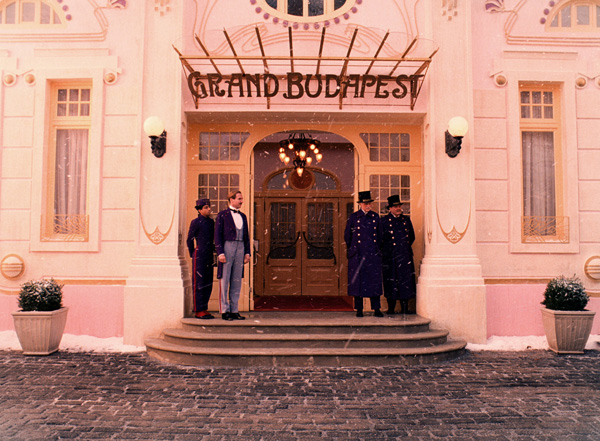 |
German ConnectionDiscussions for this project started in October 2012, before principal photography got underway in February 2013 in Germany. Although Gabriel and the team were not present on set during the shoot, LOOK Effects built a new Stuttgart-based operation expressly for the production of this film. The company also helped to secure financing for the film from the local MFG, the centre of excellence for IT, media and film, of the German state of Baden-Württemberg where the shoot was located. Initially Wes expected the film would only need 90 to 100 visual effects shots. But when LOOK Effects’ VFX supervisor Gabriel Sanchez received and broke down the script, sequence by sequence, he soon identified several specific sequences in the story that would require effects work to make them come to life for the audience and fit into the story. The wide and establishing shots of the Grand Budapest Hotel’s elegant exterior were mainly achieved with a miniature. The hotel and other miniatures were shot on a RED camera at 4K, while the live action plates were shot on film. Because the looks of the photography and the 4K imagery had to be matched in post production, the 4K RED imagery – including a full set of stills – fortunately had the abundant detail and colour information the team at LOOK needed to properly integrate the miniature elements into the plates. |
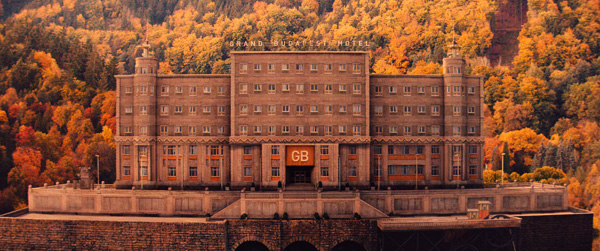 |
Not Quite PhotorealThese wide shots of the hotel usually involved quite a few elements to composite together, of which the miniature would only be one. Gabriel said, “For the early shot when the camera pans over from a rocky landscape to the hotel front, the production handed us the trees, the landscape, the people on green screen, the giant rock with the elk posed on top – as well as the hotel miniature shot. Sometimes the hotel was supplied instead as an image of a highly detailed oil painting. It took us a while to learn exactly how to use these elements to achieve the result Wes was after. “His look is detailed and full of life but not photoreal. At first though, because a lot of the elements were supplied at a very high resolution with clear angles and texture information and supported precise tracking, we placed everything very accurately, re-created the dimensions, even added an overlay to improve the textures. But Wes thought we had taken the ability to achieve photoreal looks too far. He likes the feeling of a miniature and preferred only to use the detail when and where he wanted it to support the story.” Sometimes the backgrounds weren’t provided in any form, requiring LOOK to create a matte painting, digitally re-creating the trees, the mountainscape and the colour scheme. The lighting could be a special challenge, sometimes demanding a lighting change across the front that they created using several different images to give a time-lapse feel. |
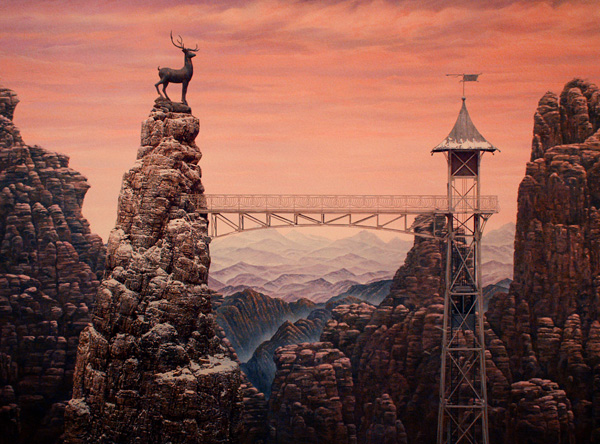 |
New Light“We had all that detail from the close-up stills, so we knew how everything looked in most conditions,” Gabriel explained. “We were able to stitch some of these close-ups into the overall miniature shot for the right look, and then also create a 3D model in 3ds Max that helped provide the relief of the building – the turrets bulging out, front door recess, window architecture and so on – and used this model to correctly recreate the lighting across the façade with shadows and hotspots.” As no HDRIs had been captured for any shots, the lights were tweaked shot by shot, again in 3ds Max. The live action outside the hotel was shot at an old department store that lacked the Grand Budapest Hotel’s architectural detail. It was dressed only at first floor level including a set around the front door area constructed as a façade with details like the flower pots, decorative trees and rosy colours. However beyond this, the grey exterior of the existing building was visible, which LOOK colour corrected and altered with matte paintings and set enhancements so that all shots were consistent with the miniature as it looked in the wide shots. Whenever parallax was an issue, the matte paintings were projected. |
 |
|
“This mountain matte painting was another instance when we were producing work at too photorealistic a level, and we had to tone down the detail and literal, physical accuracy to preserve the miniature’s quality in the shot. Nevertheless, having the detail available did give Wes flexibility to decide just how to use it.” Inside a VisionAs much as anything else, Gabriel feels that working on this film helped LOOK understand how to communicate with Wes effectively enough to deliver his vision exactly as he saw it. “When he talked with us about putting a ‘blur’ or ‘defocus’ somewhere in a shot, he wasn’t really talking about camera vision but about what the eye sees. Objects at a distance have their own softness,” he said. |
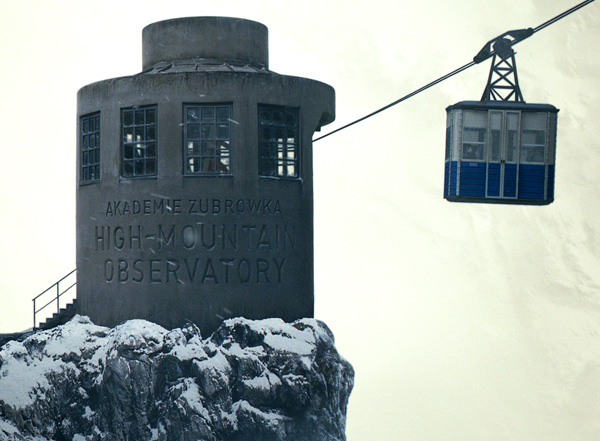 |
|
When Gabriel began to understand what Wes was after - that realistic softness - he understood that there was no need to work their digital matte paintings up to 4K resolution and therefore they usually worked at 3K or 2K. It was more important to gain enough real estate to take the camera anywhere within that observatory environment for the frantic chase sequence, and re-create the scene just as Wes wanted it, flying around the entire 360° world. He didn’t want the feeling that bits of the environment had passed by before - flipped, reversed or re-used in some way. Everything should be genuinely in place. Stitching it TogetherAll of their matte paintings could be accurately stitched together to accommodate reverse angle shots, for example, of the skiers and sledders shot on green screen. Throughout the complex chase, skiers passed signage and other set pieces that served as landmarks and had to appear correctly whether the camera was taking a character’s point of view or looking back at them. Also, if a series of shots was cut, two backgrounds would have to be stitched together for continuity. |
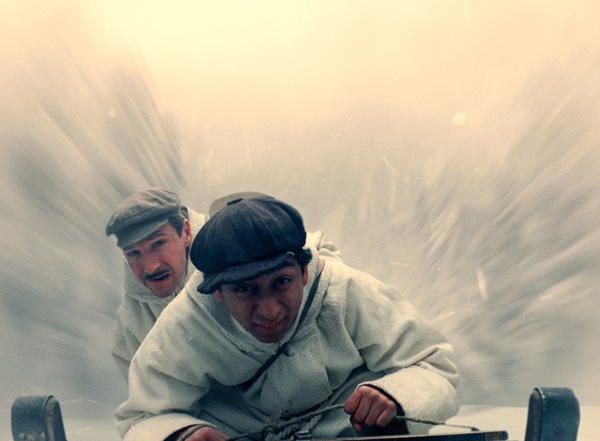 |
|
The production used a tiny 3 or 4-inch figure on skis to stand in for Jopling and literally moved the figure across the stage snapping a series of images to record his progress across the view. The frames were passed to LOOK to clean up, put together into a scene, and ensure that the timing flowed correctly. They couldn’t lose the stop motion look all together but had to create a motion blur pass and take control of the lighting and shadows to avoid causing a ‘break’ in the action, both within that sequence and the whole film. Double TakeThe 360° environment especially helped in a comical section of the chase between the observatory and a monastery. The characters are riding gondolas on an old-fashioned ski lift. When we see wide views of the gondolas suspended over the snow covered mountain, the shots are actually of miniature gondolas, while the live action scenes of the actors on board were shot on green screen in a studio. |
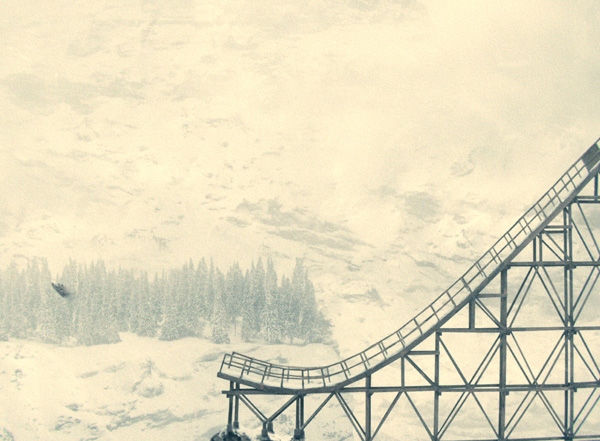 |
|
Grain and NoiseBridging the filmmaking styles required a conscious effort from Gabriel, from the initial script breakdown stage through to the end. First it was a matter of reading through the script and noting down where exactly they would need a set of matte paintings, or shots integrating miniatures, or stop motion – although at that stage they didn’t know exactly what visual effects and fixes might come down the pipeline as shots arrived. Meanwhile, once they had scans and footage, Gabriel made a point of working directly with LOOK’s R&D department on the challenge of the mixed footage and image types. He wanted to have processes in place for dealing with the different resolutions, formats, lighting and scales. Everything was pulled into the Flame to determine specific hurdles. “Telling ourselves, ‘this part of the shot is on film, this part on RED,’ we analysed how they could best be put together – to the point of analysing the grain in every image channel. While the film had grain and was usually shot anamorphically, the digital images were at a different resolution and shot with a spherical lens.” |
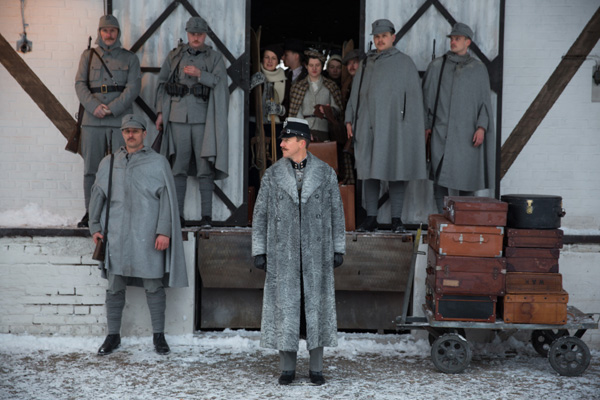 |
|
Mainly using Nuke with plug-ins to correct the grain and noise issues, they also developed a Nuke script using nodes to analyse and adjust the grain in each channel, aiming to re-create the same film weave across the shots without losing detail. Seriously InvisibleParticles were created and handled in Nuke to match the practical snowflakes that fall on many outdoor shots. Jopling’s chase sequence especially needed not only fog and mist but also snow flakes for atmosphere and to provide a sense of direction and speed. They introduced snow flying in specific directions looking overhead at the two stop motion passes, compositing in as many as six layers of particles and depth. |
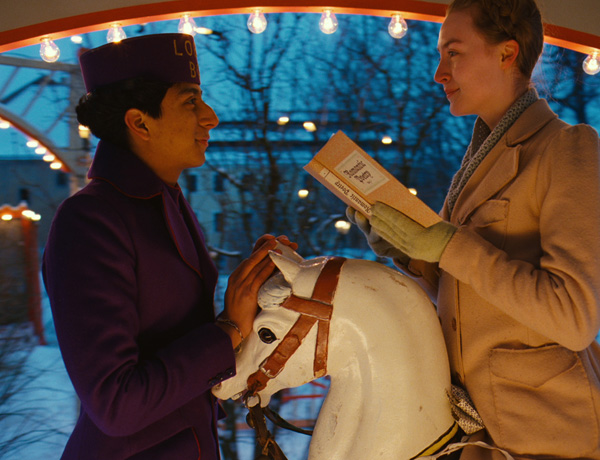 |
Invisible effects were taken seriously throughout the film. Some of the hotel interiors were an example. As Jude Law walks down one of the corridors, which had been dressed to match the 1930s pink and lavender colour scheme and décor, the team had to change all fittings and colours to the later orange-and-yellow look of the 1960s. The first shots in the spa also show it as it was in the ‘60s, crumbling and grubby in blue and white. But in one, important shot we get to see it in its heyday, gleaming in the pink and lavender shades, for which the team adjusted the lighting and removed the broken tiles. www.lookfx.com |
| Words: Adriene Hurst Images: Courtesy of Twentieth Century Fox |


















